
-- by Max Jaquerod, edited by Silke Rottermann © Eurodressage
This article series documents the progress the Swiss warmblood dressage horse Fantastico (by Frascino-Hofrat) is making in his training with Swiss amateur dressage rider Max Jaquerod who strictly trains after classical principles. The series started in June 2023 after „Fanti“ was bought until now.
Since I bought Fanti from the Swiss Army as a 6-year-old in June 2023, he has made steady progress and each season has stepped up a level which we tackled in dressage competition. As the 2025 season slowly comes to a close and we look back, my horse has established himself well at medium level, at which he repeatedly placed throughout the season. He is ready to make the transition to the advanced level in 2026.
However, Fanti not only reliably succeeded in the discipline of dressage, but also competed in three Working Equitation shows at novice level with my girlfriend Ivana and he won all of them, including the Swiss Championships at that level at the beginning of October.
The first lines of this article might leave the impression that our focus has shifted from training to competing, but nothing is more untrue. That Ivana was so successful in a different discipline without having the possibility to specifically train the trail part with its peculiar obstacles is the result of Fantastico’s general training. From the beginning I focused on his suppleness which the German speaking riders more universally call "losgelassenheit" as well as his responsiveness to the aids.
I firmly believe both are undeniable and incorruptible indications if a training is going the good way or is a one-way-street.
Mental Relaxation and Suppleness
Josef Neckermann, the first World Champion in dressage and legendary German entrepreneur, remarked in his autobiography "Erinnerungen" that „usually a horse is good natured, willing and docile“. He stressed that praise leads to a trustful obedience of the horse who, by nature, wants to please, something leading to and maintaining mental relaxation.
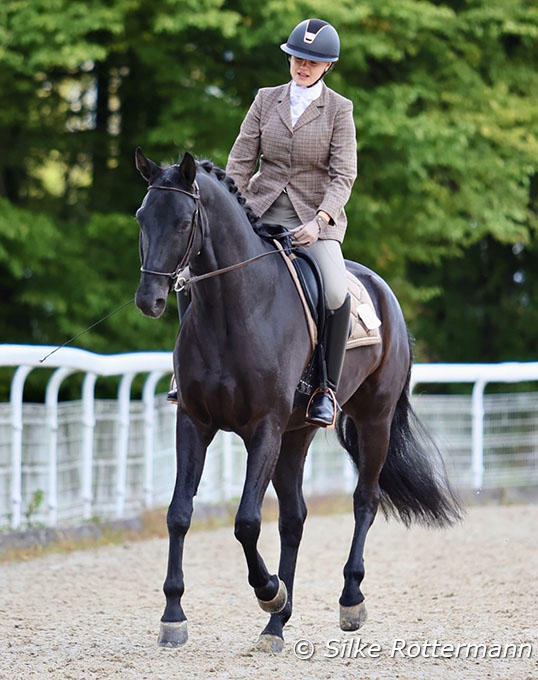
It is obvious that only a horse who trusts the rider (who himself should not be tense or nervous in any way, neither mentally nor physically) is able to listen to the aids and to focus on work. If this is not the case, for whatever reason, the rider needs to use pressure to make himself be heard and that in turn stresses the horse even more. It is a vicious circle which leads to nothing and which we have to avoid at all cost.
From the beginning of our partnership, I took utmost care to never ask too much of Fanti in terms of learning new things, of taking him physically and mentally beyond a limit of what he was capable of at this point in his training. It is my obligation not only to adapt our working program to Fanti’s general level of training, but equally important to his day form which naturally varies. That way he developed a deep trust in the rider that whatever is asked of him, he can handle well.
Only once the state of mental relaxation is reliably existing, working on suppleness through gymnastic exercises is effectively and sustainably possible. When the horse feels well within himself his natural willingness and studiousness
are secured and become firmly established attitudes of which the rider can take advantage in a reasonable way.

In the course of the two years I am training with Fantastico, his suppleness increased, he is much stronger and more balanced than in 2023 when I bought him. This in turn also affects his mental state: He feels very self-confident now in what he does and tackles new things and surroundings with no hesitation, even showing the cheeky side of an amiable rascal now and then; something he did not do at the beginning when he was rather timid.
Improved Responsiveness
Feeling mentally and physically well and prepared for what I ask of him, Fantastico has likewise significantly improved regarding his thoroughness / responsiveness. It is logical that with a certain degree of losgelassenheit a horse becomes more responsive and that only that way we can ride without putting a horse under pressure which he then would respond to with a lack of suppleness and with tension.
By aiming to perfect a horse’s losgelassenheit, which includes mental relaxation and physical suppleness, we also achieve greater throughness. In his masterpiece "Von der Koppel bis zur Kapriole," published 1949, the legendary Waldemar Seunig defined throughness as "the ability and the readiness of the horse to react to the aids of the rider informally, obediently and without hesitation."
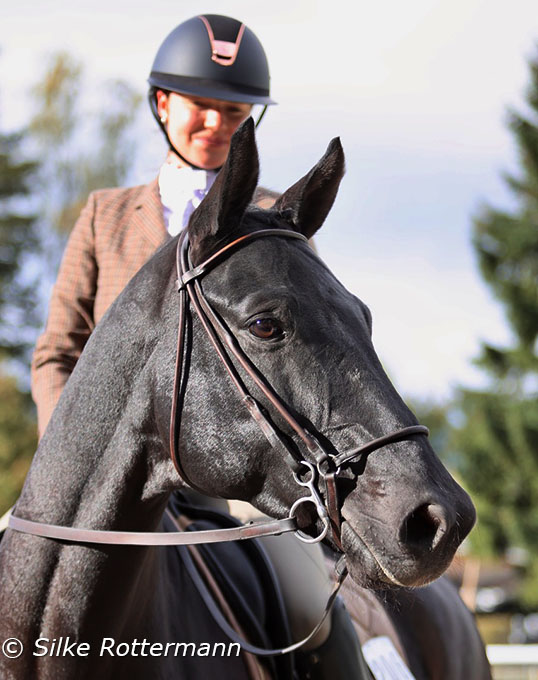
the past two years
It goes without saying that my horse’s throughness or responsiveness grew, the better his losgelassenheit became, which shows that these two parts of the training scale require and complement each other constantly. Bringing losgelassenheit and throughness together step by step means to build on the horse’s natural good nature and will to work and please. Josef
Neckermann referred to in the quote that I mentioned at the beginning of the text. It shows in a horse which moves naturally with a content expression and a rider who is able to sit quietly and act with refined aids.
Putting Fanti’s Losgelassenheit and Throughness To The Test
While I prefer training at home without pressure and consider competing a burden sometimes, my girlfriend Ivana enjoys it more than I do. When she had to retire her beloved mare Black Pearl last year and with her second mare GB Scala only a yearling, she started Fanti in entry level eventing as well as novice dressage classes last year. She then decided to give it a try in the comparatively new discipline of Working Equitation. Whereas this discipline has traditional roots in the working riding style, it has become a serious competition sport with regular European and World championships, even though it is not part of the FEI yet.
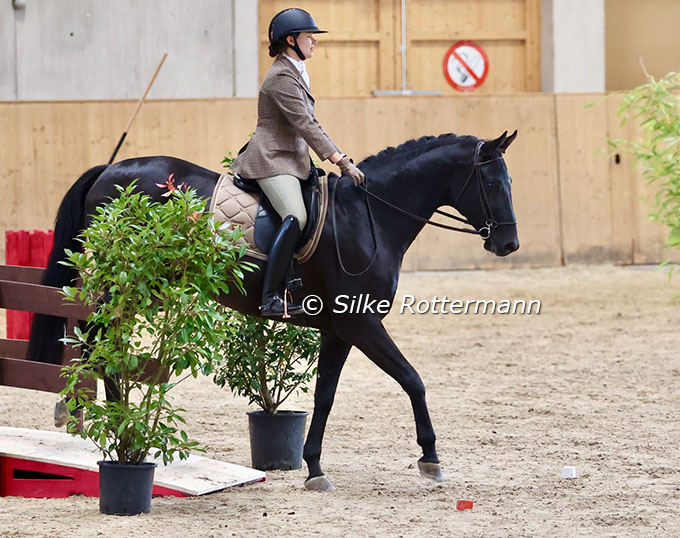
As we only have very few of such obstacles at our disposal in Berne, Ivana first did a Working Equitation clinic with Fanti to see how he reacts to this new challenge. Though he had his ears firmly pricked at the beginning of this clinic, he did not hesitate a moment to tackle the obstacles, even some might have scared the hell out of horses less relaxed and trusting like him: Like ringing a bell over the head of the horse at the end of a corridor of two poles on the floor which one has to leave vwith a rein-back to opening and closing a swinging gate while passing through it.
We practiced at home and got him more acquainted with the few obstacles we have at our disposal in Berne; like going forwards and backwards in a lane of two poles, do a slalom or going sideways over a pole on the floor. At the beginning the latter scared him a bit and first he was insecure where to put his legs in order to avoid stepping on the pole, but as Fanti’s dressage training led to a horse whose throughness is very advanced, he still listened to Ivana’s aids and soon became calmer and more confident in this exercise.

during the passing of a gate
This excursion to the world of Working Equitation in 2025, which I did not know well, was a valuable confirmation for me that we are on the right way with our training and that Fanti’s rideability is available pretty everywhere. More so: It makes him a very pleasant safe ride and therefore provides a growth in self-confidence for horse and rider alike.
"The overall impression of the relaxed and supple horse is calm, the face content, the movements fluid and harmonious," German vet and author Udo Bürger defined a dressage horse with a high degree of losgelassenheit in his 1959 published „Way to Perfect Horsmanship“. I think we can see it in the photos illustrating this article. It characterizes my horse’s way of going which makes me truly happy.
It’s A Choice: Losgelassenheit Or Keeping The Lid On The Cooker?
I think we are all in unison that for some horses and for many different reasons it is harder to achieve mental relaxation and work in muscular harmony, free of negative tension in the muscles, than for other horses.
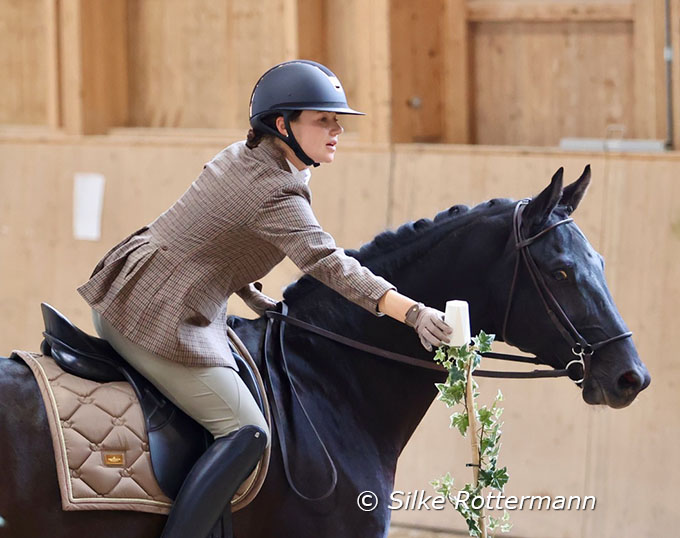
an inch as Ivana picks up a cup during a trail obstacle
Germany’s renowned equine therapist Stefan Stammer mentioned in a seminar a few years ago that if we want to show spectacular trot "it is always the decision between investing years of serious training to achieve a maximum of relaxation, strength and elegance or to just take the horse’s head high and sacrifice the back of the horse for his leg performance."
To rely on short-cuts instead of achieving maximum losgelassenheit also means that riding and competing become a tightrope walk which some riders perform very successfully in our days. A truly relaxed and responsive horse presents a very different picture and a very different expression—it is this picture which the public needs to get used to and needs to appreciate again. In my very own idea of a dressage horse it should represent the epitome of rideability in every possible situation.
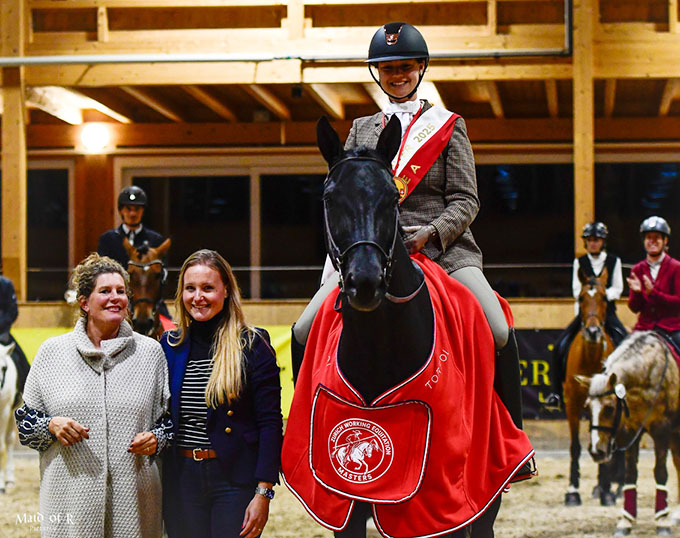
(Photo © Brigitte Graffenberger)
I once read a quote of Dr. Reiner Klimke: „I ride to win“. For me there is nothing wrong or even condemnable in this statement, the important question is HOW we get there and achieve being successful. When one of the most important elements of the globally so highly valued "German training scale" is often visibly lacking, when the dressage riders at the CHIO in Aachen have to borrow horses to take part in the legendary "Farewell of Nations" on Sunday evening, when so many horses proverbially do not "smile" anymore in the dressage arena, somehow too many dressage riders have not understood or are not interested in the concept of dressage training in which losgelassenheit und throughness should be the focus.
References
- Bürger, Udo, Vollendete Reitkunst, Paul Parey-Verlag, Berlin und München 1959.
- Neckermann, Josef, Erinnerungen, Ullstein-Verlag, Berlin 1990
- Seunig, Waldemar, Von der Koppel bis zur Kapriole, Fretz & Wasmuth- Verlag, Zürich 1949.
- Fromming and Stammer Seminar 2021
Photos © Silke Rottermann
Related Link
Fanti's Progress - Part I: What Good Dressage Training Can Do to a Horse
Fanti's Progress - Part II: "The Rider Must Control Himself Before He Can Control His Horse"
Fanti's Progress - Part III: "Taking a Step Up While Refining the Basics"
Fanti's Progress - Part IV: A Three-Day Training Stint with Anja Beran
Fanti's Progress - Part V - Why Compete Today if You Want to Be a Classical Dressage Rider?
Fanti's Progress - Part VI: Rediscovering the Love for Dressage Through Fanti
Fanti's Progress - Part VII: On Firing the Engine by Training Outside the Dressage Arena